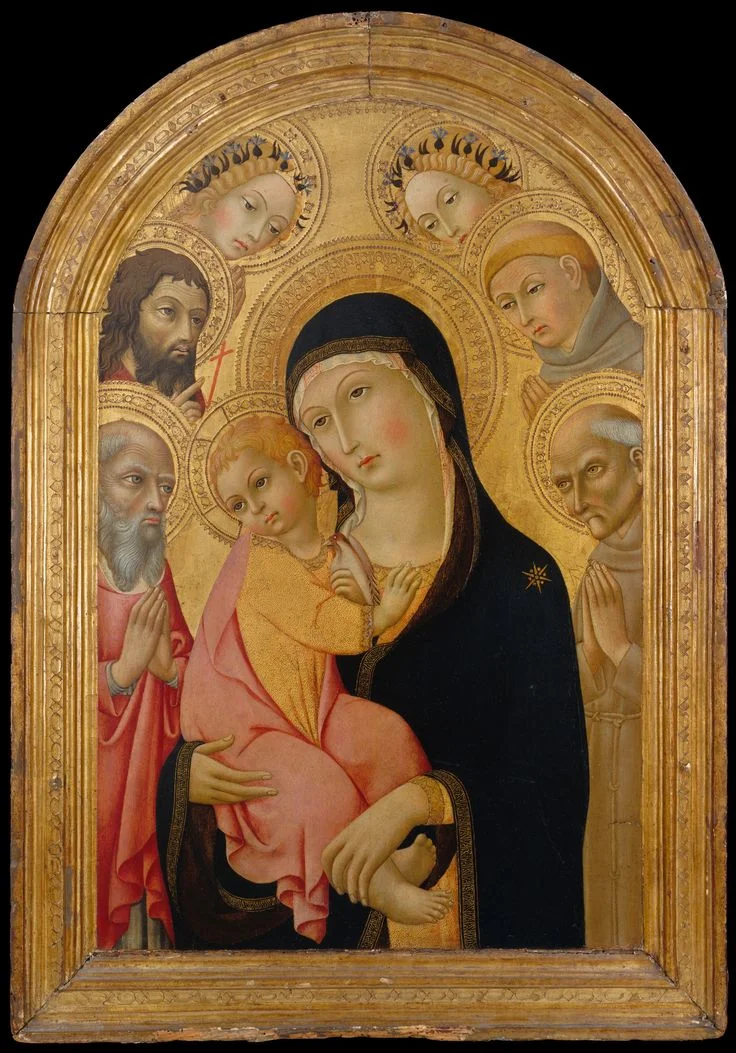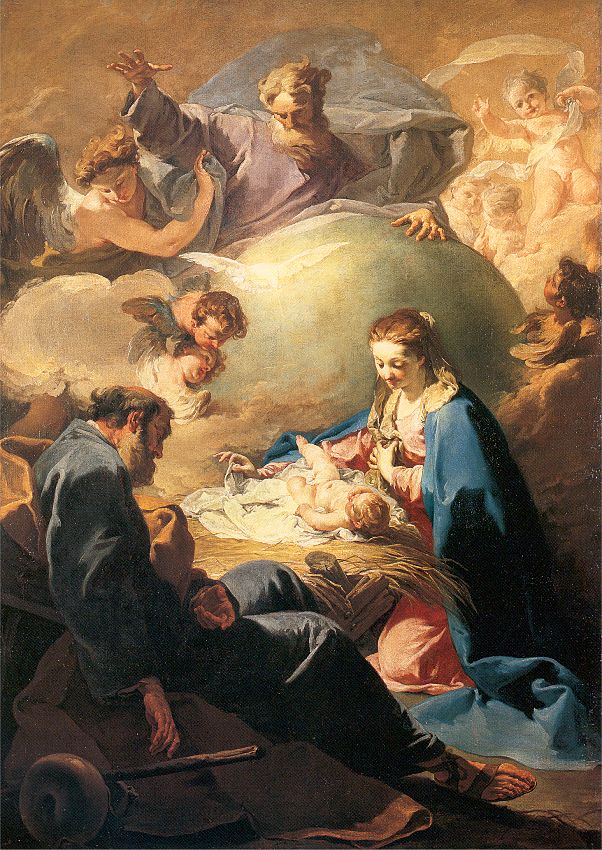If we think that God is not answering our prayer because we did not get what we wanted, that displays a lack of faith on our part.
Why Do We Kneel At Mass When the First Ecumenical Council Forbad It?
CS Lewis On The Effectiveness Of Prayer
Understanding the Ways of God
Persistence in the Face of Adversity
Meditation, Contemplation and Transformation; Praying With Sacred Art
In the Western/Christian tradition meditation and contemplation are two different things and often misunderstood. As a result of the The Beatles and the Maharishi Yogi, the words are often used interchangeably to apply to meditative practice of Eastern religions, which is different and less effective, in my experience, than the methods of Christian mysticism.
How to Pray With Sacred Art
The short answer to this question is just this: pray as you would normally, but look at sacred art as you do it. Good sacred art will promote a right attitude through the combination of content, compositional design, and stylistic elements. In this sense, the artist does the hard work in advance to make it easy and natural for us.
How to Address the Crisis in Fatherhood Head On through Prayer
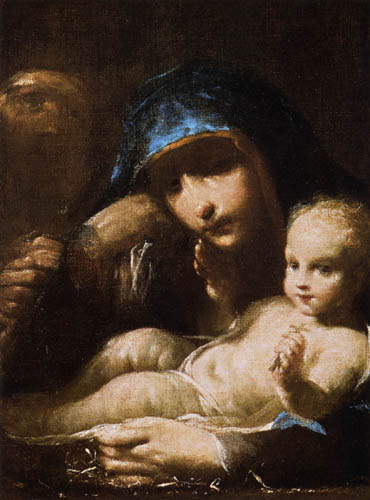 In this article I describe how it is prayer, above all, that binds families together; and the most powerful form of prayer we can pray in the home is the liturgy of the hours. Furthermore, with the father leading the prayers, we are opening the way for a powerful driving force that has effect not only within the family but also beyond the four walls of our home.
I first posted this exactly three years ago. It was in part a desire to see this home-based driving force for change that lead to the writing of the book on prayer in the home, The Little Oratory.
In this article I describe how it is prayer, above all, that binds families together; and the most powerful form of prayer we can pray in the home is the liturgy of the hours. Furthermore, with the father leading the prayers, we are opening the way for a powerful driving force that has effect not only within the family but also beyond the four walls of our home.
I first posted this exactly three years ago. It was in part a desire to see this home-based driving force for change that lead to the writing of the book on prayer in the home, The Little Oratory.
The word Oratory, incidentally means in English 'House of Prayer'. When I used to go to the London Oratory - the wonderful Catholic church in England whose liturgy was so influential in my conversion - I used to see these words on the walls around the sanctuary: domus mea domus orationis vocabitur. It was a quote from Isaiah 56:7 which is echoed in Matthew's gospel - my house shall be called a house of prayer, says the Lord. This isn't the full quote, I know there's some Latin missing there but I am handicapped by a combination of poor Latin skills and a bad memory; but here's the point, I wanted to include at least part of it because it shows the word 'orationis' - 'of prayer' - so that you can make the connection with the title of the book.
We chose this title because we wanted to communicate the idea that even the most humble house can be transformed into a house of prayer in accordance with the ideal articulated in Isaiah, and just as the London Oratory, in all its wonderful glory does. This is how a house becomes a home, however many people live there. The book we have written, we hope, helps us to fulfill that ideal and it places fathers, when we are talking of families, once more right at the centre of family and in right relationship with all others. As one might say, the father is the head and the mother is the heart. Both are necessary!
I will be doing a series of postings over the next few weeks that draw out themes discussed in more detail in the book. Anyway, here is the article....
In the exercise of the lay office in the liturgy each person participates in the sacrifice made by Christ, the supreme act of love for humanity. When we are advocates in prayer in this liturgical setting, the participation in the liturgy becomes an act of love for those people and communities with which we have a connection. Accordingly, by participating in the liturgy the family members enter into the to the mystical body of Christ who is our advocate to the Father and so participate in that sacrifice and His advocacy, on behalf of the family, too. It is the father who is the head of the family and who is called is called above the others to be in a quasi-priestly role, and is in a special position to be the advocate to God for his family. This role is executed without diminishing or replacing the advocacy of other family members.
This role of the father as advocate to the Father is a tradition that is biblical at its source, as Scott Hahn points out: ‘[In] the Book of Genesis, liturgy was the province of the Patriarchs themselves. In each household, priesthood belonged to the father, who passed the office to his son, ideally the firstborn, by pronouncing a blessing over him. In every household, fathers served as mediators between God and their families’[1] Also, just as at Mass we pray for the head of state, family members might pray for the head of the family (and by extension, to all communities and groups that we belong to).
We hear that there is a crisis of fatherhood at the moment, and for all the ways that this manifests itself in our society, one wonders if at root, part of the cause at least is the loss of this sense of advocacy for the family by one who is assigned that special role. A visible example of this aspect of fatherhood is powerful for children in learning to pray and inspiring them to do so regularly; and valuable for boys especially as a demonstration that prayer is a masculine thing to do.
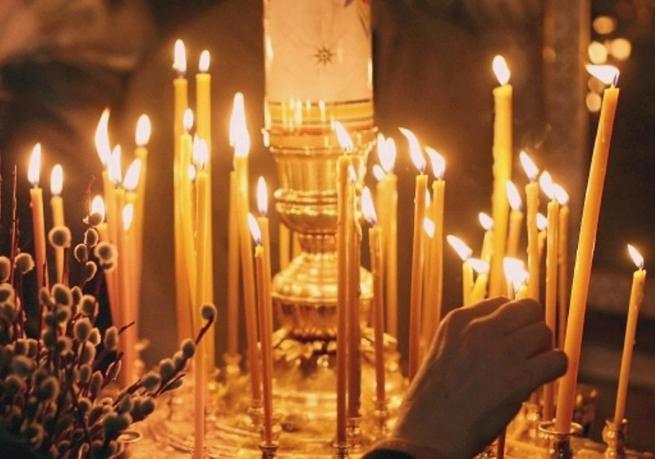 The liturgical activity of the home is the liturgy of the hours because it need not be done in a church and does not need a priest participating in order to be valid, the lay office is sufficient. The ideal therefore is that the father leads the family in the liturgy of the hours, visibly and audibly. If this were to common practice, I believe it would help to reestablish prayer as something that men do and will promote a genuine, masculine fatherhood as well as encouraging vocations to the priesthood amongst boys through this masculine example of liturgical piety.
The liturgical activity of the home is the liturgy of the hours because it need not be done in a church and does not need a priest participating in order to be valid, the lay office is sufficient. The ideal therefore is that the father leads the family in the liturgy of the hours, visibly and audibly. If this were to common practice, I believe it would help to reestablish prayer as something that men do and will promote a genuine, masculine fatherhood as well as encouraging vocations to the priesthood amongst boys through this masculine example of liturgical piety.
Something that would help to reinforce this is a domestic shrine. This is a visible focus in the home for prayer and the Eastern practice of creating and icon corner is particularly good for this. I will never forget seeing an Orthodox family doing their night prayers in front of the icons. The father led the prayers and all sang together or took their turn singing their prayers in the simple but robust Eastern tones. What impressed me was how all the children right down to the youngest who was four, wanted to take their turns and emulate their father. At one point two of the children argued about whose turn it was and Dad had to come in and arbitrate! They had a small incense burner burning and several long slender orange ochre beeswax candles burning in front of the icons. Each stood in reverence, facing the icon corner, occasionally crossing themselves. All the senses and faculties, it seems were directed for prayer as part of and on behalf of the family.
The families who have resolved to do this say to me that full family involvement is not always possible. It is inevitable that often family members will be too busy to join in and some will not want to. Nevertheless, the father resolved to make it clear that he was committing to regular prayer for the family and that all family members were invited at least to join in, so even if the prayer took place with only the father taking part, he was prepared to make that sacrifice on behalf of his family. And when the father is not with the family, for example if at work, he still strives to follow that liturgical rhythm of prayer and when does so, he does so on behalf of his family still.
I am only recently a father, but even when I was single and I prayed the liturgy of the hours I tried to remember to think of myself as participating in some way on behalf of my wider family and the various social groups that I am a member of, including work. Through my personal relationships, and this is still the case, those groups are present in the liturgy, to some degree, when I am. It is one way I can emulate Our Lord by participating in His sacrifice, and make a sacrifice for those with whom I relate. My hope is that will play a small part in bringing God's grace into these groups of people so that they might become communities supernaturally bound together in love. In my prayers, every morning, I consciously dedicate my liturgical activity to all those groups and with whom I am connected so I think of myself as representing my family, my friends, my work, the Church, social groups and so on, perhaps naming any individuals that are on my mind at that time. if, during the day I am not in a position to recite an hour, which can be often, I try mentally to mark the hour with a small prayer to maintain that sense of rhythm.
Images: top two are both paintings of the Holy Family by Giuseppe Crespi painting around the 1700; below: the Nativity with God the Father and the Holy Ghost by Giambattista Pittoni, Italian, 17th century
[1] Scott Hahn, Letter and Spirit, pub DLT, p28
The Dynamic of Prayer with Baroque Sacred Art - Why the Style of the Painting Makes You Pray Well

And how it is connected with the rosary. Have you ever had the experience of walking into an art gallery and being struck by a wonderful painting on the far side of the room. You are so captivated by it that you want to get closer. As you approach it, something strange happens. The image goes out of focus and dissolves into a mass of broad brushstrokes and unity of the image is lost. Then, in order to get a unified picture of the whole you have to recede again. The painting is likely to be an Old Master produced in the style of the 17th-century baroque, perhaps a Velazquez, or a Ribera, or perhaps later artists who retained this stylistic effect, such as John Singer Sargent. I recently made a trip to the art museum at Worcester, Massachusetts and there was a portrait by Sargent there that was about 12ft high and forced us back maybe 35ft so that we could view the whole.
This is a deliberately contrived effect of baroque painting. These paintings are created to have optimum impact at a distance. It is sad that the art gallery is the most likely place for us to find any art, let alone any sacred art that conforms to its principles. The stylistic elements of the baroque relate to its role firstly as a liturgical art form in the Counter-Reformation. The baroque of the 17th century is also the last style historically that Benedict XVI cites as an authentic liturgical tradition - where there is a full integration of theology and form - It should be of no surprise that this has an impact upon prayer.
The best analysis of the stylistic features of the baroque of the 17th century that I have seen is in a book about Velazquez, published in 1906 and written by RAM Stevenson (the brother of Robert Louis). RAM Stevenson trained as a painter in the same studio in Paris as John Singer Sargent. This studio, run by a man called Carolos Duran was unusual in the 19th century in that it did not conform to the sentimental academic art of the time (such as we might have seen in Bougeureau, whose painting is shown above), but sought to mimic the style the great artists of the 17th century, such as Velazquez. In this he says: “A canvas should express a human outlook on the world and so it should represent an area possible to the attention; that is, it should subtend an angle of vision confined to certain natural limits of expansion.[1] ” In other words we need to stand far enough away from the painting so that the eye can take it in as a single impression. Traditionally (following on from Leonardo) this is taken to be a point three times longer than the greatest dimension of the painting. This ratio of 3:1 is in fact an angle of 18°, slightly larger than the natural angle of focused vision of the eye, which is about 15°. When you stand this distance away, the whole painting can be taken in comfortably, without forcing the eye to move backwards and forwards over it to any extent that is uncomfortable.
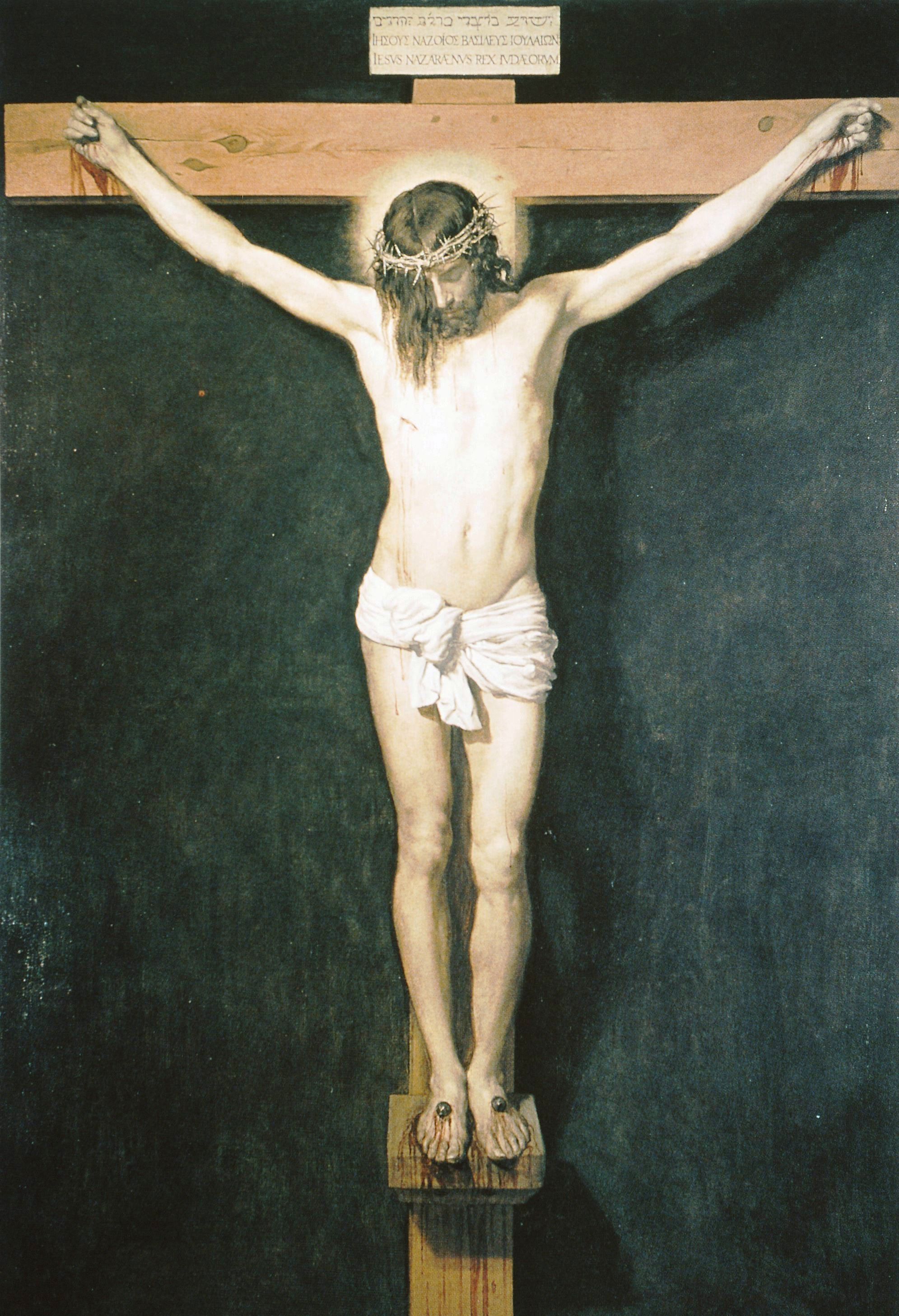 If the intention is to appear sharp and in focus at a distance of three times the length of the canvas, it must be much painted as much softer and blurred on the canvas itself. In practice this means that when one approaches a canvas, the brush stroke is often broader than one first expected. So that if we do examine a painting close too, it is often hard to discern anything, it almost looks like a collection of random brush strokes. The whole thing only comes together and knits into an image once we retreat again far enough to be able to see it as a unified image. This property makes baroque art particularly suitable for paintings that are intended to have an impact at a distance. The scene jumps out at us.
If the intention is to appear sharp and in focus at a distance of three times the length of the canvas, it must be much painted as much softer and blurred on the canvas itself. In practice this means that when one approaches a canvas, the brush stroke is often broader than one first expected. So that if we do examine a painting close too, it is often hard to discern anything, it almost looks like a collection of random brush strokes. The whole thing only comes together and knits into an image once we retreat again far enough to be able to see it as a unified image. This property makes baroque art particularly suitable for paintings that are intended to have an impact at a distance. The scene jumps out at us.
There is an additional optical device that contributes to this. The composition of the painting is such that the figures are painted in the foreground. Two things: the placement of the horizon; and the relationship between the angle of vision of the perimeter of the canvas and that angle which spans each figure within, affect the sense of whether the image is in the foreground, middle ground or background in relation to the observer. Baroque art tends to portray the key figures in the foreground. When these two effects are combined the effect is powerful.
If we look consider the very famous painting of Christ on the cross by Velazquez, for example. Its appearance at a distance is of a perfectly modeled figure. As we approach we see that much of the detail is painted with a very loose, broad brush. I have picked out the loin cloth and face as detail examples. The artist achieves this effect is achieved by retreating from the canvas, viewing the subject at a distance and then walking forward to paint the canvas from memory. Then after making the brushstroke the artist returns to review the work from the position from which he intends the viewer to see it several feet back. I learnt this technique when I studied portrait painting in Florence. I was on my feet, walking backwards and forwards for two three-hour sessions a day (punctuated by cappuccino breaks, of course). Over the course of an academic year I lost several pounds! I was told, though I haven’t been able to confirm the truth of it, that Velazquez did not feel inclined to do all that walking, so had a set of brushes made that had 10ft handles.
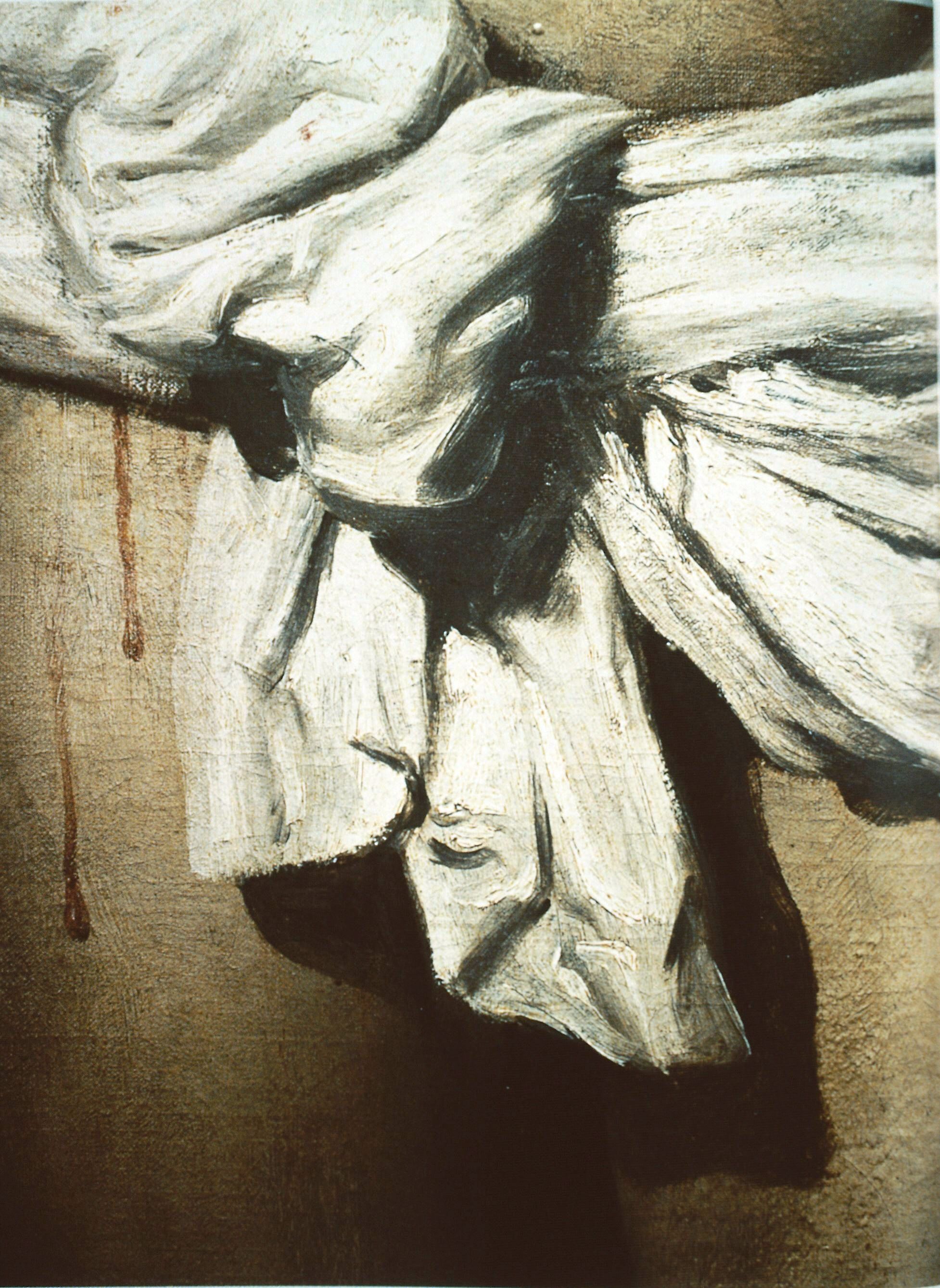 This dynamic between the viewer and the painting is consistent with the idea of baroque art which is to make God and his saints present to us here, in this fallen world. There may be evil and suffering, but God is here for us. Hope in Christ transcends all human suffering. The image says, so to speak, ‘you stay where you are – I am coming to you. I am with you, supporting you in your suffering, here and now’. The stylistic language of light and dark in baroque painting supports this also. The deep cast shadow represents evil and suffering, but it is always contrasted with strong light, representing the Light that ‘overcomes the darkness’.
This dynamic between the viewer and the painting is consistent with the idea of baroque art which is to make God and his saints present to us here, in this fallen world. There may be evil and suffering, but God is here for us. Hope in Christ transcends all human suffering. The image says, so to speak, ‘you stay where you are – I am coming to you. I am with you, supporting you in your suffering, here and now’. The stylistic language of light and dark in baroque painting supports this also. The deep cast shadow represents evil and suffering, but it is always contrasted with strong light, representing the Light that ‘overcomes the darkness’.
This is different to the effect of the two other Catholic liturgical traditions as described by Pope Benedict XVI, the gothic and the iconographic. These place the figures compositionally always in the middle ground or distance, and so they always pull you in towards them. As you approach them they reveal more detail. (See a previous article on written for the New Liturgical Movement on the form of icons for more the reasons for this).
In this respect these traditions are complementary, rather than in opposition to each other. It has since struck me that the mysteries of the rosary describe this complementary dynamic also. They seem to describe an oscillating passage from earth to heaven and back again that helps us understand that God is simultaneously his calling us from Heaven to join him, but He is also with us here and helping to carry us up there, so to speak. If we consider the glorious mysteries, for example: first Christ is resurrected from the dead and then he ascends to heaven. Then He sends the Holy Spirit from heaven to be with us. Then we consider how Our Lady followed him, in her Assumption, and she and all the saints are in glory praying for us to join them. Both dynamics take place at the Mass itself. Christ comes down to us and is really present in Blessed Sacrament. As we participate in the Eucharist, we are raised up to Him supernaturally and then through Him and in the Spirit to the Father.
[1] RAM Stevenson, The Art of Velazquez, p30.
How to Pray With Visual Imagery
It is now more than three and a half years since I started this blog so first of all I would like to thank so many of you for your interest and your comments. I am currently involved in several book projects which will be published in the early part of next year - more information to come. In order to give myself time to write these, I thought I would reduce my postings to one fresh piece per week. However, it also occurred to me that many of you who read this, will not have seen much of what I posted in the first two years. In my mind, these are foundational to my thinking and shed light on much of what I write now, so I thought they would be worth repeating. So for these two reasons I thought I would replay some of these foundational posts. So for the next couple of months, I will alternate old and new. The first replay was first published in April, 2010:
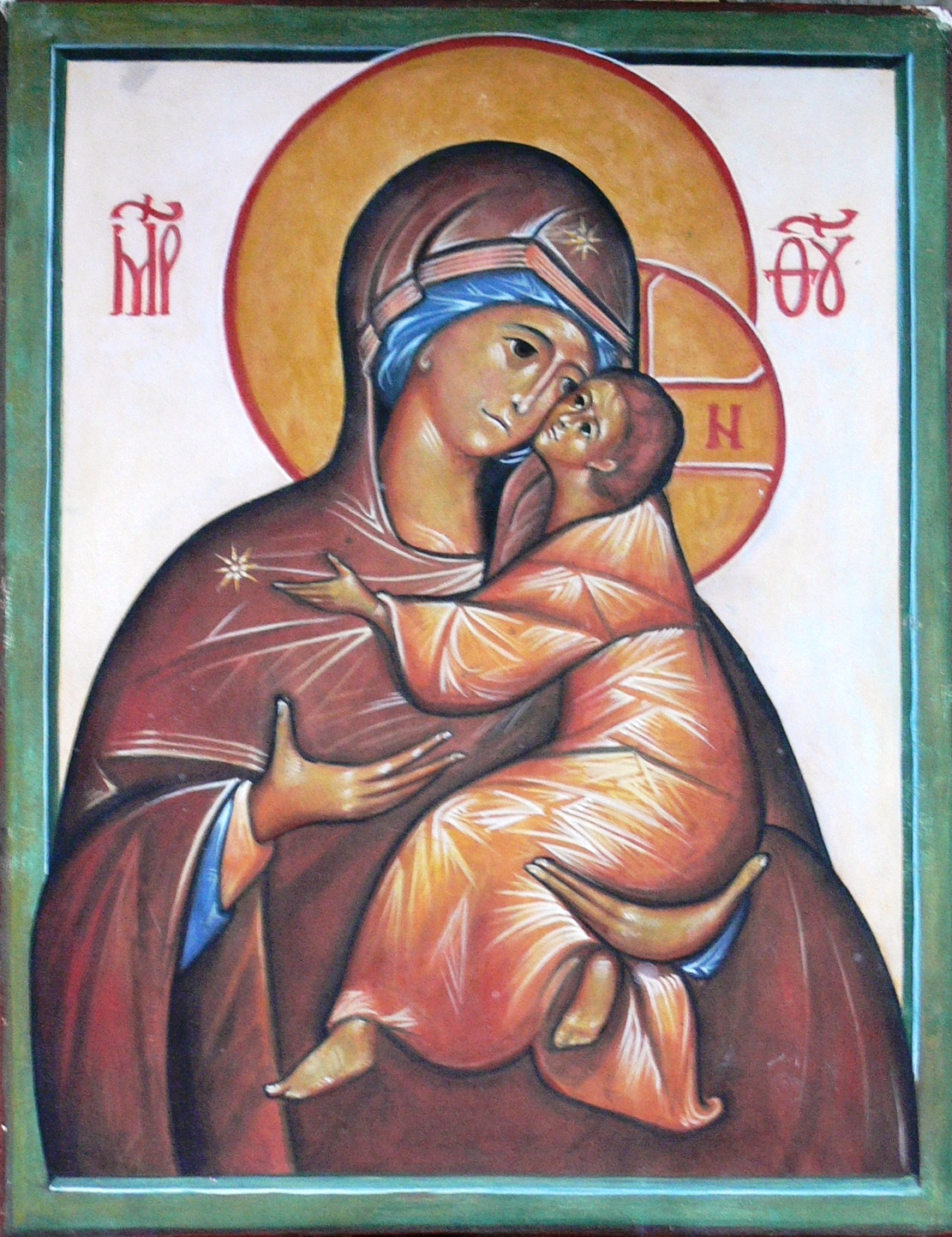 When I first started painting icons I was, of course, interested in knowing as well how they related to prayer. I was referred by others (though not my icon painting teacher) to books that were intended as instruction manuals in visual prayer. I read a couple and perhaps I chose badly, but I struggled with them. One the one hand, they seemed to be suggesting some sort of meditative process in which one spent long quiet periods staring at an icon and experiencing it, so to speak, allowing thoughts and feelings to occur to me. Being by nature an Englishman of the stiff-upper-lip temperament (and happy to be so) I was suspicious of this. I had finally found a traditional method of teaching art that didn’t rely on splashing my emotions on paper, and here I was being told that in the end, the art I was learning to produce was in fact intended to speak to us through a heightened language of emotion. Furthermore, the language used to articulate the methods always seemed to employ what struck me as pseudo-mystical expressions and which, I suspected, were being used to hide the fact that they weren’t really saying very much.
When I first started painting icons I was, of course, interested in knowing as well how they related to prayer. I was referred by others (though not my icon painting teacher) to books that were intended as instruction manuals in visual prayer. I read a couple and perhaps I chose badly, but I struggled with them. One the one hand, they seemed to be suggesting some sort of meditative process in which one spent long quiet periods staring at an icon and experiencing it, so to speak, allowing thoughts and feelings to occur to me. Being by nature an Englishman of the stiff-upper-lip temperament (and happy to be so) I was suspicious of this. I had finally found a traditional method of teaching art that didn’t rely on splashing my emotions on paper, and here I was being told that in the end, the art I was learning to produce was in fact intended to speak to us through a heightened language of emotion. Furthermore, the language used to articulate the methods always seemed to employ what struck me as pseudo-mystical expressions and which, I suspected, were being used to hide the fact that they weren’t really saying very much.
So I started to ask my teacher about this and to observe Eastern Christians praying with icons. What struck me was that prayer for them seemed to be pretty much what prayer was for me. They said prayers that contained the sentiments that they wished to express to God. The difference between what they did and what I did at that time was that they turned and looked at an icon as they prayed. Also, when at home, often happily and without embarrassment they sang their prayers using very simple, easily learnt chant. Before meals, for example, the family would stand up, face an icon of Christ on the wall and sing a prayer of gratitude or even just the Our Father.
As I learnt more about icons through learning to paint them, I realized that every aspect of the style of an icon is worked out to engage us in a dynamic that assists prayer – through its form and content the icon will do the work of directing our thoughts to heaven. In short I don’t need to ‘do’ anything. The icon does the work for me.
The iconographic form is not the only one to do this. The Western Catholic tradition is very rich and has also the Baroque and gothic art forms that are carefully worked out to engage the observer in a dynamic of prayer, although in different ways. If the icon draws our thoughts to heaven, the baroque form is designed in contrast to have an impact at a distance in order to make God present on earth. The gothic figurative art is the art of pilgrimage, or of transition from earth to heaven, and stylistically it sits between the iconographic and baroque. It is the ‘gradual psalm’ of artistic form. Just like the spires of its architecture, it spans the gap between heaven and earth so that we have a sense both of where we going to and where we are coming from. I will discuss how the form of each tradition achieves in the next articles I write.
So the advice I was given was to ditch the books about praying with icons, and learn first to pray. Then as I pray always aim to have visual imagery that I allow to engage my sight and which assists. St Augustine said that those who sing their prayers pray twice. I would add that those who look at visual imagery as well pray three times (and if we use incense four times, and consider posture five). This process of engaging different aspects of the person in addition to the intellect is a move towards the ideal of praying with the whole person. This is what praying from the heart means. The heart is the vector sum of our thoughts and actions. It is our human centre of gravity when both body and soul are considered. It is the single point that, when everything is taken into account, defines what I am doing. It is the heart of us, in the sense of representing the core. This is why it is a symbol of the person. It is a symbol of love also because each of us is made by God to love him and our fellow man. It symbolizes what we ought to be rather than, necessarily, what we are. The modern world has distorted the symbolism of the heart into one of desire and ‘heartfelt’ emotion, precisely because these are the qualities that so many today associate with the essence of humanity.
The liturgy is ultimate form of prayer. By praying with the Church, the mystical body of Christ, we are participating in ‘Christ's own prayer addressed to the Father in the Holy Spirit. In the liturgy, all Christian prayer finds its source and goal.’[1] Therefore, the most important practice of praying with visual imagery is in the context of the liturgy. For example, when we pray to the Father then we look at Christ, for those who have seen Him have seen the Father. The three Catholic figurative traditions in art already mentioned were developed specifically to assist this process.
Just as the liturgy is the ‘source and goal’ of prayer, so liturgical art is, I would argue, the source and goal of all Catholic art. The forms that are united to the liturgy are the basis of Catholic culture. All truly Catholic art will participate in these forms and so even if a landscape in the sitting room, will point us to the liturgical. We cannot become a culture of beauty until we habitually engage in the full human experience of the liturgy. In the context of visual art, this practice will be the source of grace from which artists will be able to produce art that will be the basis of the culture of beauty; the source of grace and from which patrons will know what art to commission; and in turn by which all of us will be able to fulfill our vocation, whatever it may be, by travelling on the via pulchritudinis, the Way of Beauty, recently described by Pope Benedict XVI.
Of course, each individual (depending upon his purse) usually has a limited influence on what art we see in our churches. However, as lay people, we can pray the Liturgy of the Hours and control imagery that we use. The tradition of the prayer corner, in which paintings are placed on a small table or shelf at home as a focus of prayer, is a good one to adopt. We ‘orientate’ our prayer towards this, letting the imagery engage our sight as we do so. We can also sing, use incense and stand, bow, sit or kneel as appropriate while praying. A book I found useful in this regard, which describes traditional practices is called Earthen Vessels (The Practice of Personal Prayer According to the Patristic Tradition) by Gabriel Bunge, OSB
Does this mean that meditation of visual imagery is not appropriate? No it does not. But as with all prayer that is not liturgical, it is should be understood by its relation to the liturgy. So just as lectio divina, for example, is good in that it is ordered to the liturgy because through it our participation in the liturgy is deepened and intensified. So, perhaps, should meditation upon visual imagery should be understood in relation to the use of imagery in the liturgical context. Also, I would say that it is useful, just as with lectio, to avoid the confusion between the Western and Eastern non-Christian ideas of meditation and contemplation are. I was recommended a book recently that helped me greatly in this regard. It is called Praying Scripture for a Change – An Introduction to Lectio Divina by Dr Tim Gray.
[1] CCC, 1073
Quoting the Eminently Quotable - Newman on the Veneration of Images
 I am currently reading a new book on Newman which has recently come to my notice. It is The Quotable Newman - Definitive Guide to His Central Thoughts and Ideas. Published by Sophia Press it is compiled by Dave Armstrong with a forward written by Joseph Pearce.
I am currently reading a new book on Newman which has recently come to my notice. It is The Quotable Newman - Definitive Guide to His Central Thoughts and Ideas. Published by Sophia Press it is compiled by Dave Armstrong with a forward written by Joseph Pearce.
It is arranged by topic in alphabetical order, over 100 of them taken from 40 different documents, and under each topic, for example, Original Sin, the Fall of Man there are a series of quotations, usually up to a couple of paragraphs long on each topic. To someone like me who does not know the full body of Newman's well (to put it mildly) this arrangement is helpful. It seems to me that I can access directly and quickly what Newman actually said and then if I wish to investigate further, seek elsewhere the document in full via the reference. This is otherwise difficult because the titles of the documents do not always tell you what he is speaking about eg Letter to the Duke of Norfolk.
So, from the section Images, Use and Veneration Of, I have a couple of things that caught my eye: 'In England Catholics pray before images, not to them. I wonder whether as many as a dozen pray to them, but they will be the best Catholics, not ordinary ones. The truth is that sort of affectionate fervour which leads one to confuse an object with its representation, is skin-deep in the South and argues nothing for a worshipper's faith, hope and charity, whereas in a Northern race like ours, with whom ardent devotional feeling is not common, it may be the mark of great spirituality. As to the nature of the feeling itself, and its absolute incongruity with any intellectual intention of addressing the image as an image, I think that it is not difficult for anyone with an ordinary human heart to understand it. Do we not love the pictures we have of friends departed?... Will not a husband wear in his bosom and kiss the miniature of his wife? Cannot you fancy a man addressing himself to it, as it were reality?' [p191, taken from Letter to William Robert Brownlow, 25 October, 1863]
I cannot comment on the differences between northern and southern Catholics, but I think his observation about many of the Catholics I see is still very true today. The contrast between how Eastern Catholics, such as the Melkites, engage with the images of the saints as they pray to them, struck me long ago. The Easterners tend to turn and facing them as though the person was there and addressing the saint by looking at his face - this becomes part of the activity of liturgical worship. Whereas, in the Roman Rite churches, even if beautifully adorned, there is much less obvious direct engagement with the image. Even if Mary's image is there, I don't see people looking at her as they pray and when she is addressed by name in the same way. It isn't the only way to pray of course and there are devotions in which the image is an integral part, such as the Stations of the Cross; but the general lack is telling, I think. This is something that I think has a profound effect on the culture. The the more our senses, including the visual, are engaged directly during prayer with beauty that supports and intensifies our prayer, not only will it encourage the right interior disposition, but it profoundly forms our taste and sense of the beautiful, so changing what we choose and delight in outside the church. This, I believe, is how the culture of faith and wider culture can be powerfully connected again. In the Spirit of the Liturgy, Pope Benedict XVI talks of this separation of the two cultures and how serious this is. He says that this happened by the 19th century, when Newman lived.
How to Make and Icon Corner And Create a Domestic Church
![]() Beauty calls us to itself and then beyond, to the source of all beauty, God. God's creation is beautiful, and God made us to apprehend it so that we might see Him through it. The choice of images for our prayer, therefore, is important. Beautiful sacred imagery not only aids the process of prayer, but what we pray with influences profoundly our taste: praying with beautiful sacred art is the most powerful education in beauty that there is. In the end this is how we shape our culture, especially so when this is rooted in family prayer. The icon corner will help us to do that. I am using icon here in the broadest sense of the term, referring to a sacred image that depicts the likeness of the person portrayed. So one could as easily choose Byzantine, gothic or even baroque styles.
The contemplation of sacred imagery is rooted in man’s nature. This was made clear by the 7th Ecumenical Council, at Nicea. Through the veneration icons, our imagination takes us tothe person depicted. The veneration of icons, therefore, serves to stimulation and purify the imagination as a means of imaging God’s inspiration. This is discussed in the writings of Theodore the Studite (759-826AD), who was one of the main theologians who contributed to the resolution of the iconoclastic controversy.
Beauty calls us to itself and then beyond, to the source of all beauty, God. God's creation is beautiful, and God made us to apprehend it so that we might see Him through it. The choice of images for our prayer, therefore, is important. Beautiful sacred imagery not only aids the process of prayer, but what we pray with influences profoundly our taste: praying with beautiful sacred art is the most powerful education in beauty that there is. In the end this is how we shape our culture, especially so when this is rooted in family prayer. The icon corner will help us to do that. I am using icon here in the broadest sense of the term, referring to a sacred image that depicts the likeness of the person portrayed. So one could as easily choose Byzantine, gothic or even baroque styles.
The contemplation of sacred imagery is rooted in man’s nature. This was made clear by the 7th Ecumenical Council, at Nicea. Through the veneration icons, our imagination takes us tothe person depicted. The veneration of icons, therefore, serves to stimulation and purify the imagination as a means of imaging God’s inspiration. This is discussed in the writings of Theodore the Studite (759-826AD), who was one of the main theologians who contributed to the resolution of the iconoclastic controversy.
In emphasising the importance of praying with sacred images Theodore said: “Imprint Christ…onto your heart, where he [already] dwells; whether you read a book about him, or behold him in an image, may he inspire your thoughts, as you come to know him twofold through the twofold experience of your senses. Thus you will see with your eyes what you have learned through the words you have heard. He who in this way hears and sees will fill his entire being with the praise of God.” [quoted by Cardinal Schonborn, p232, God’s Human Face, pub. Ignatius.]
It is good, therefore for us to develop the habit of praying with visual imagery and this can start at home. The tradition is to have a corner in which images are placed. This image or icon corner is the place to which we turn, when we pray. When this is done at home it will help bind the family in common prayer.









